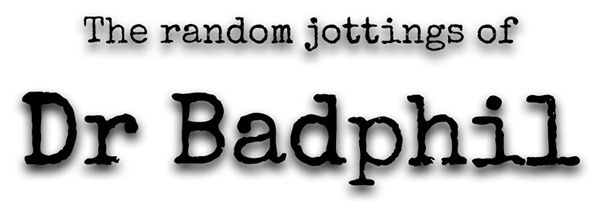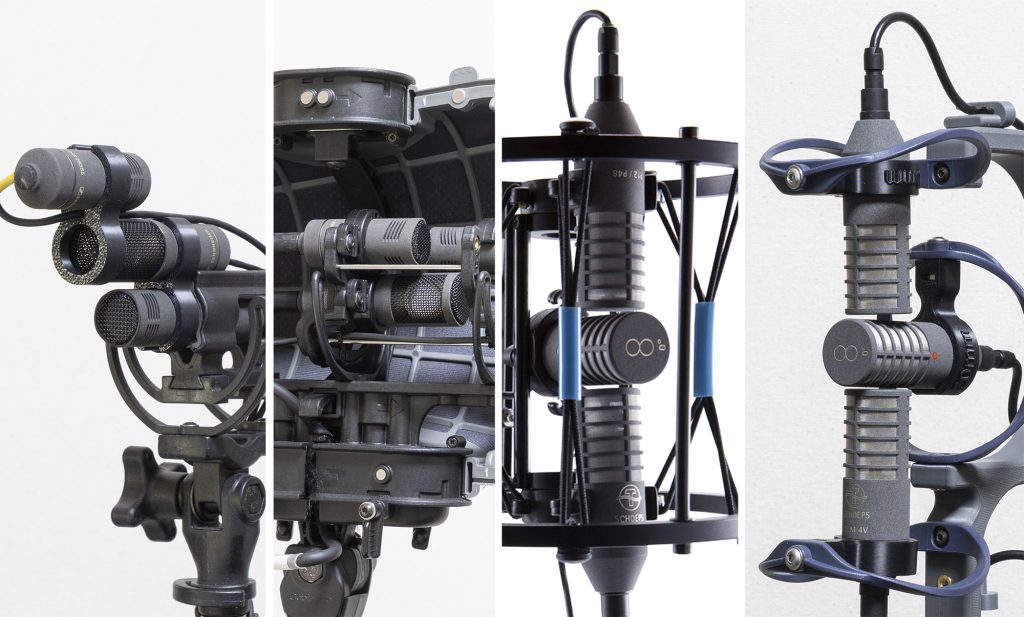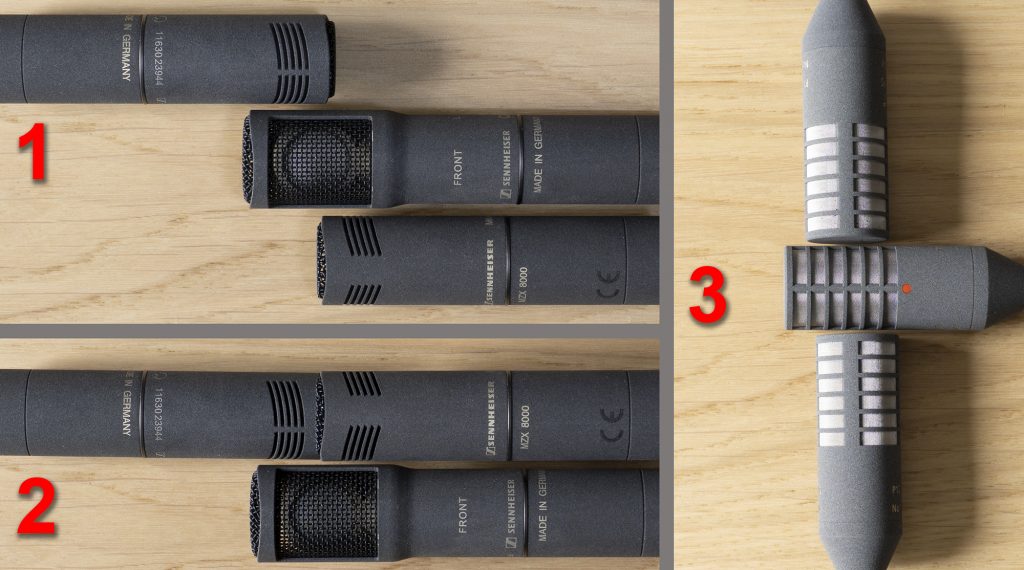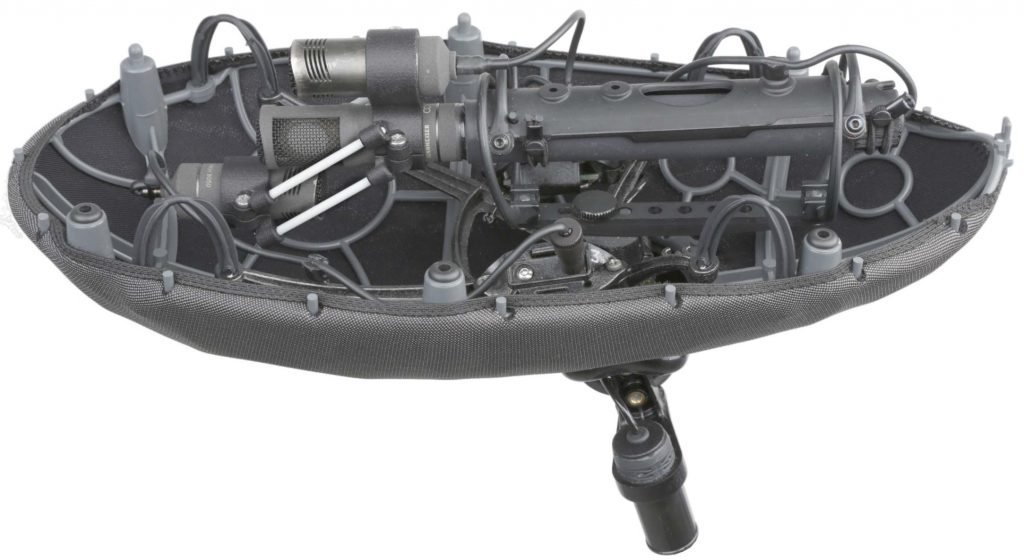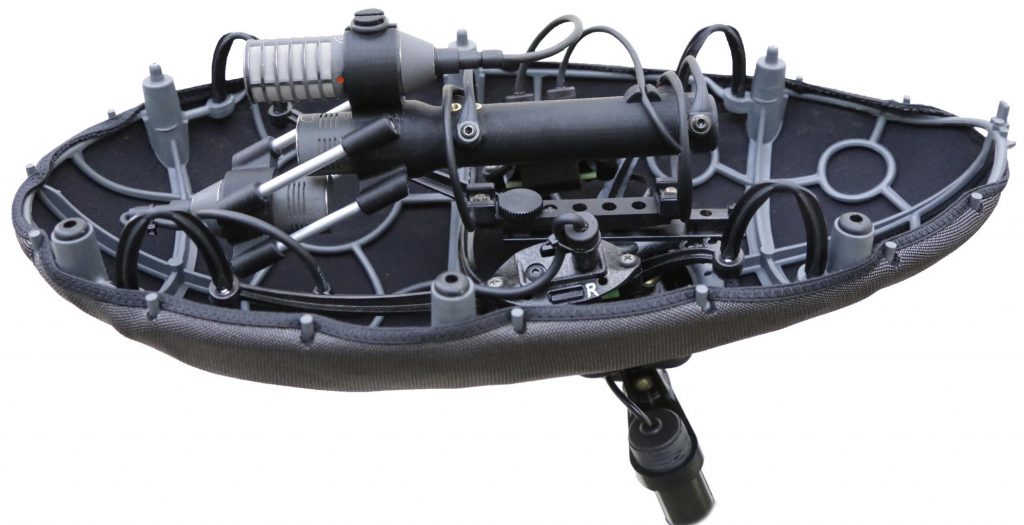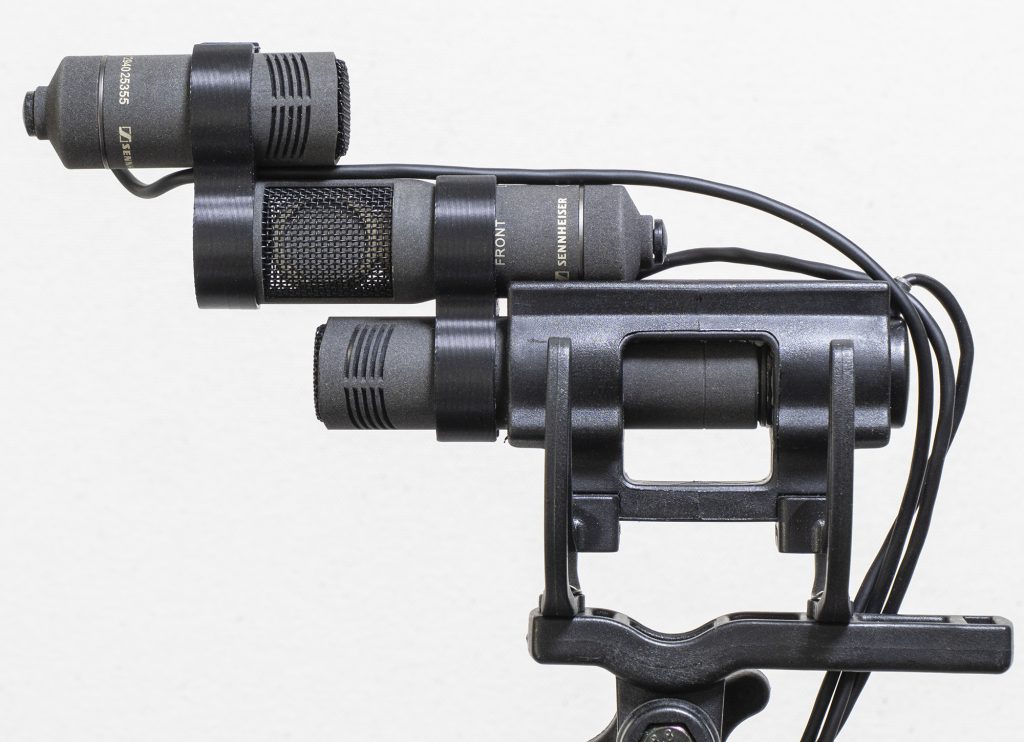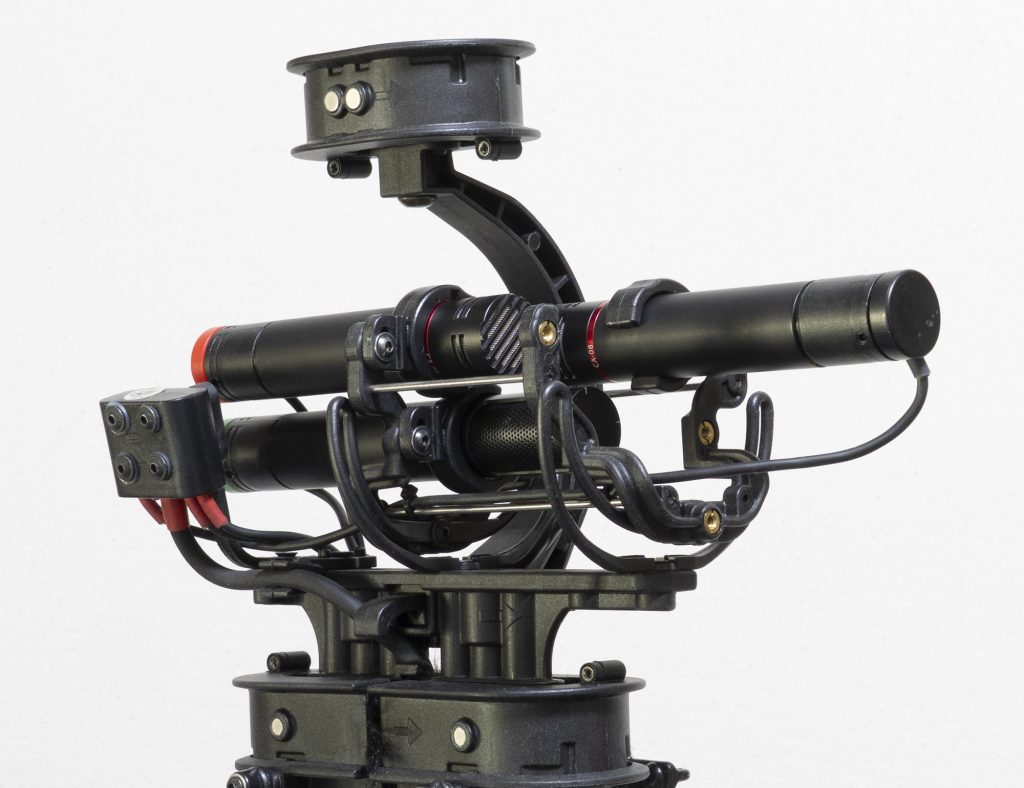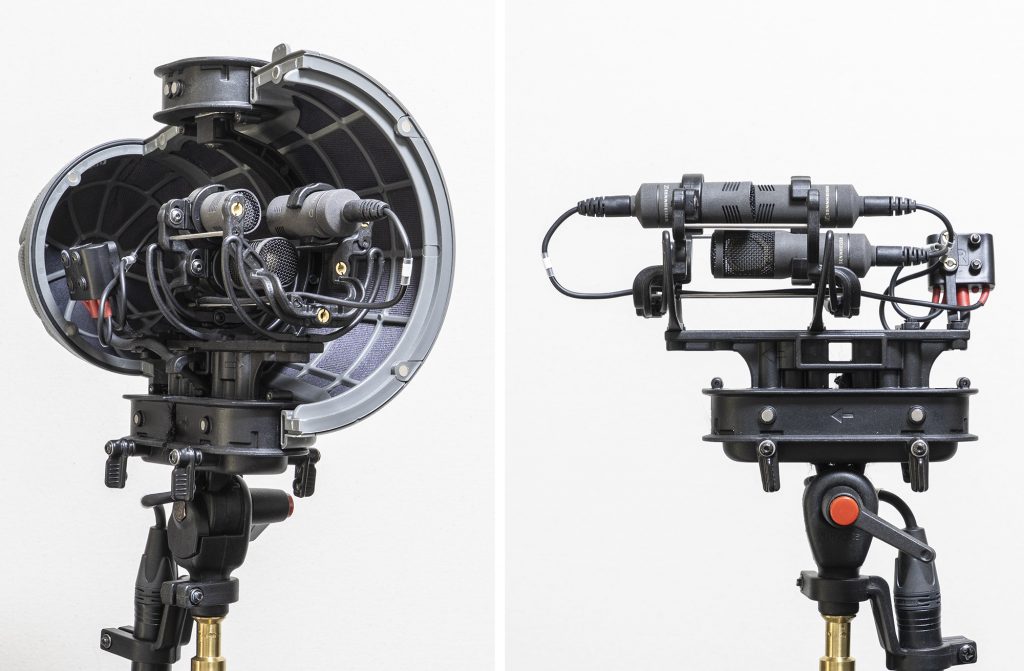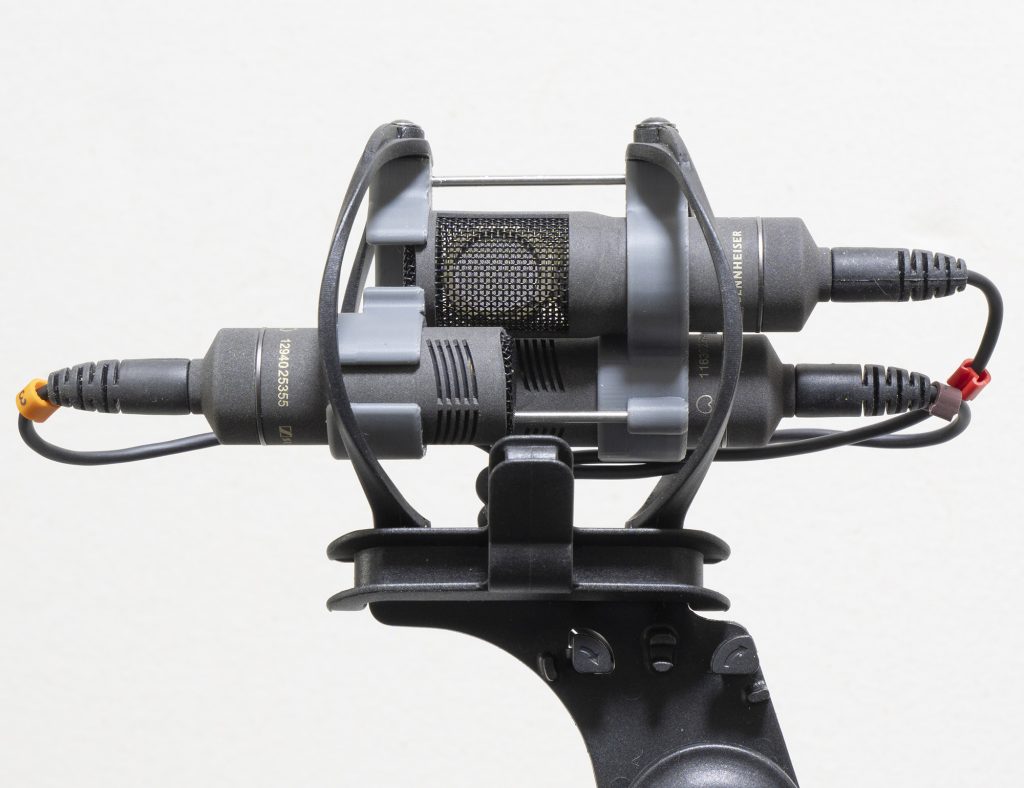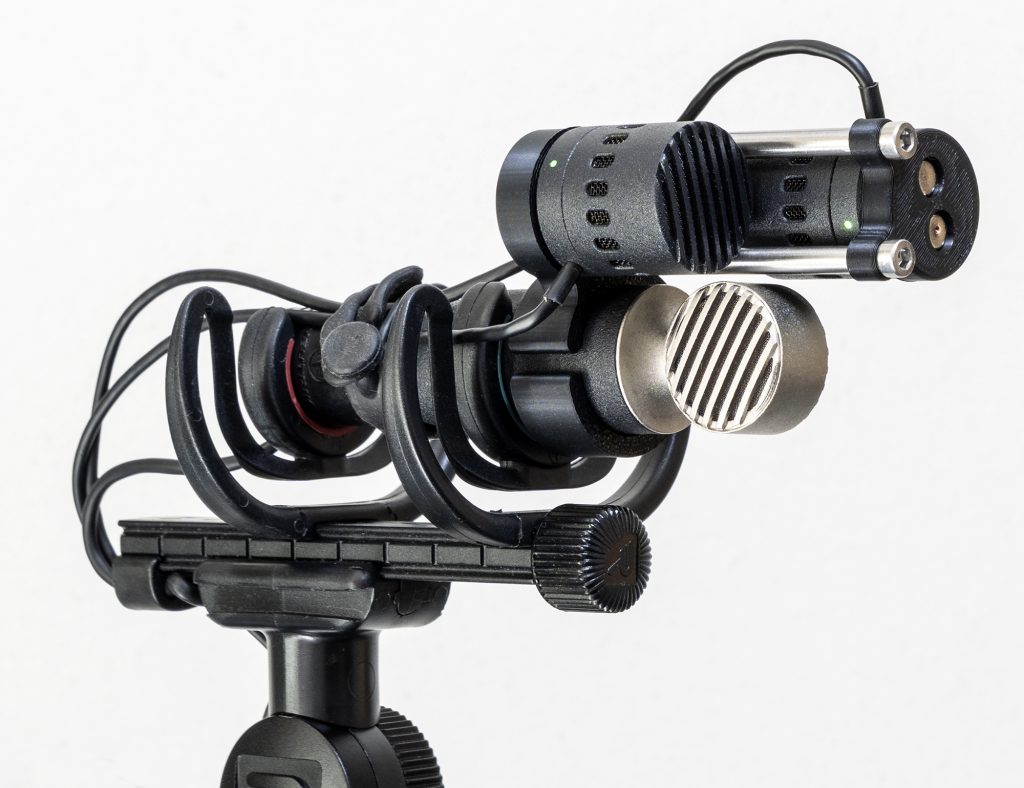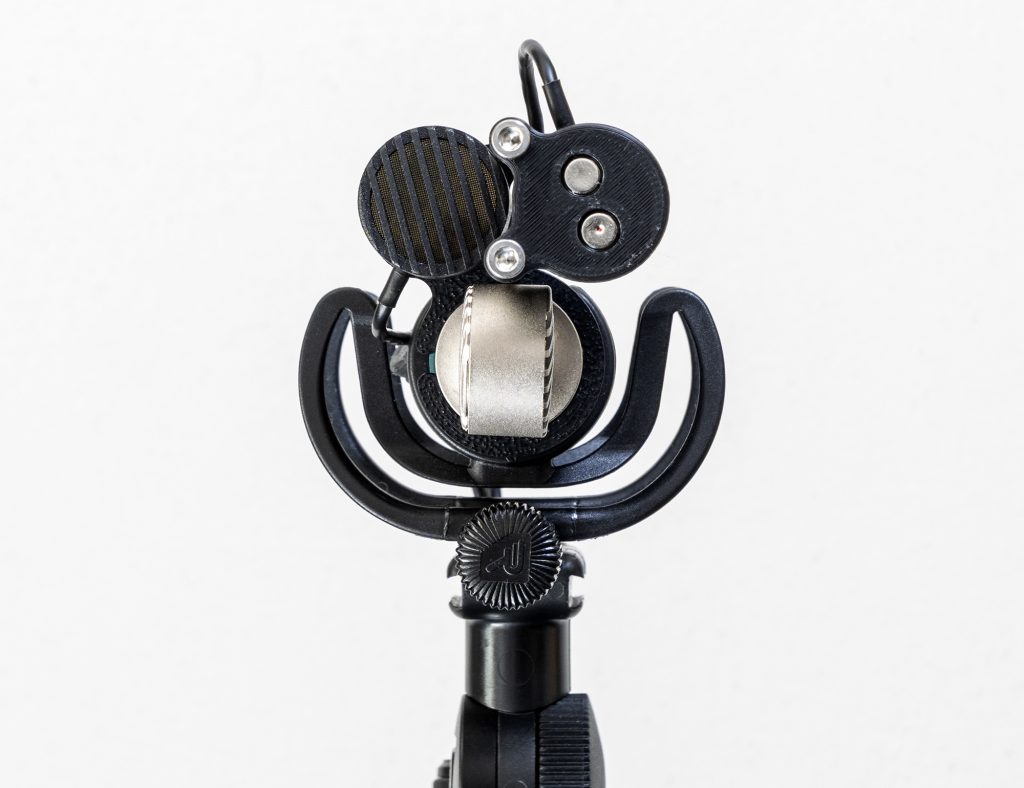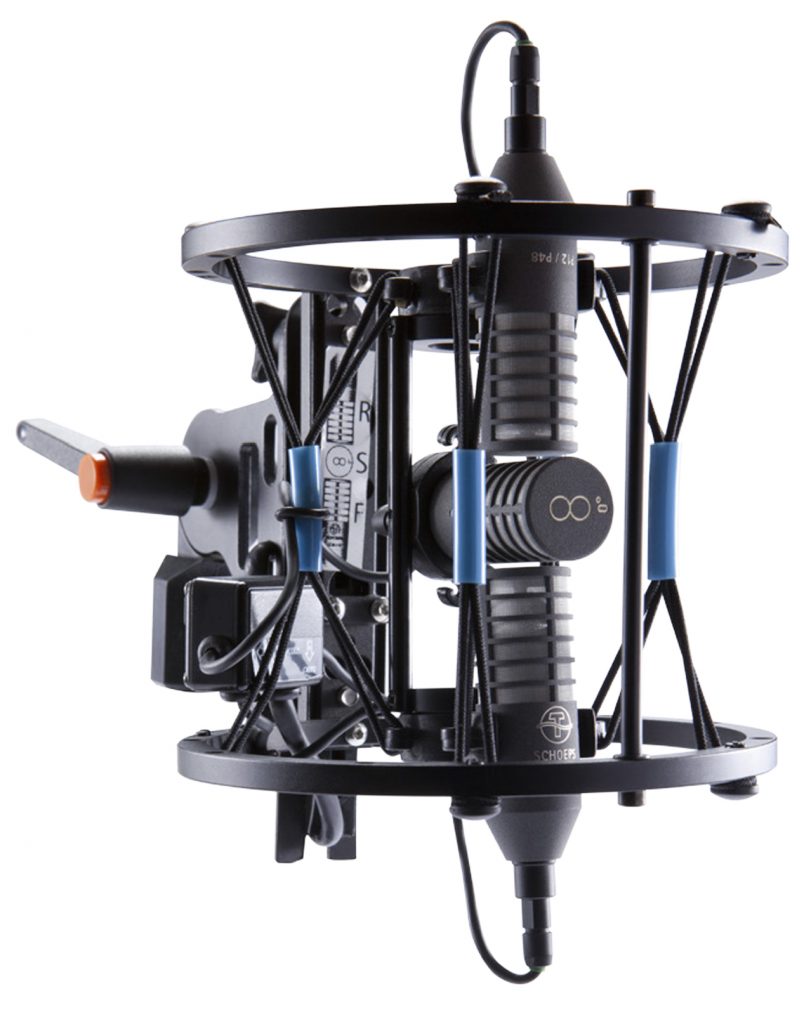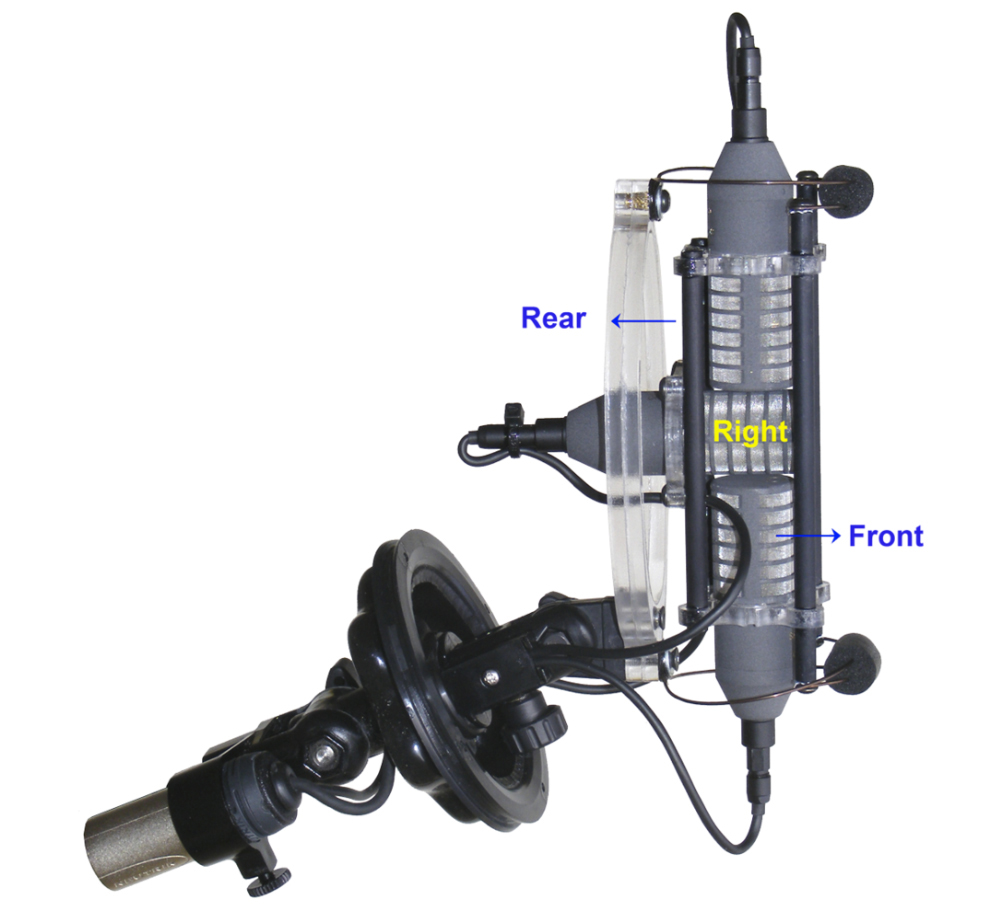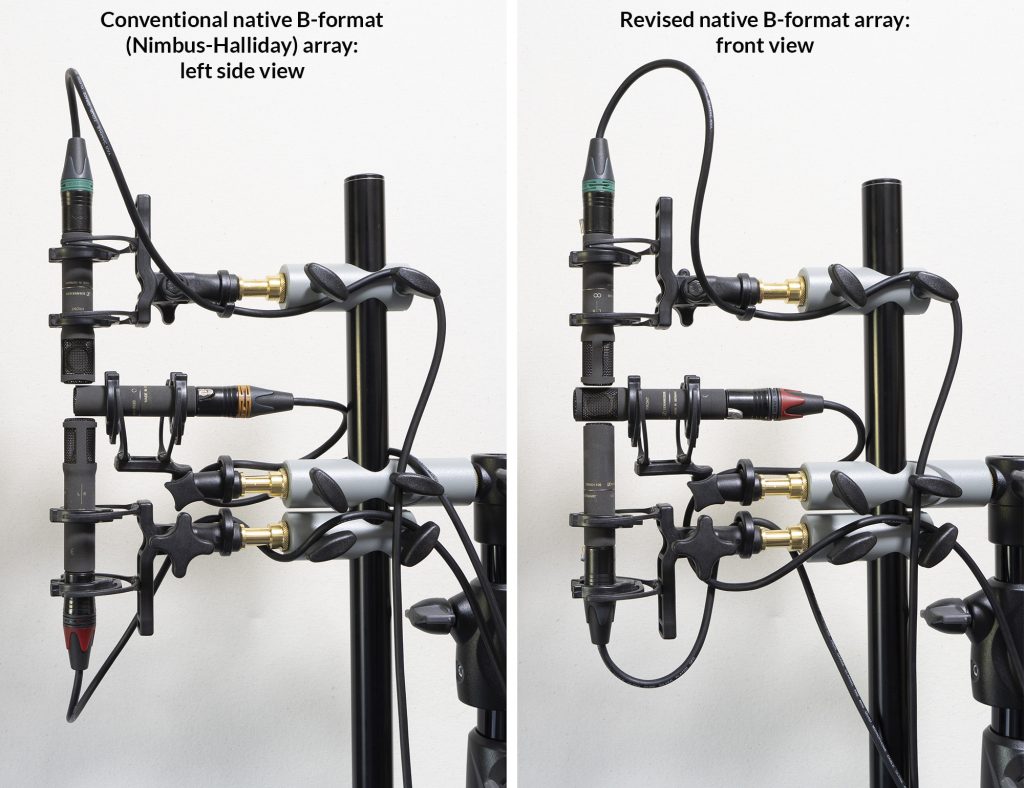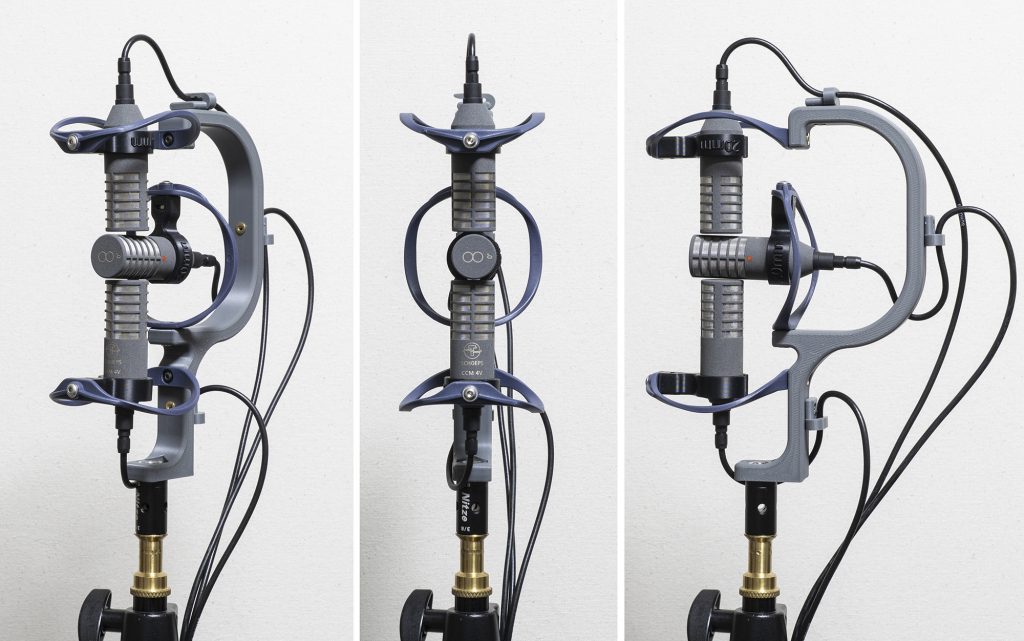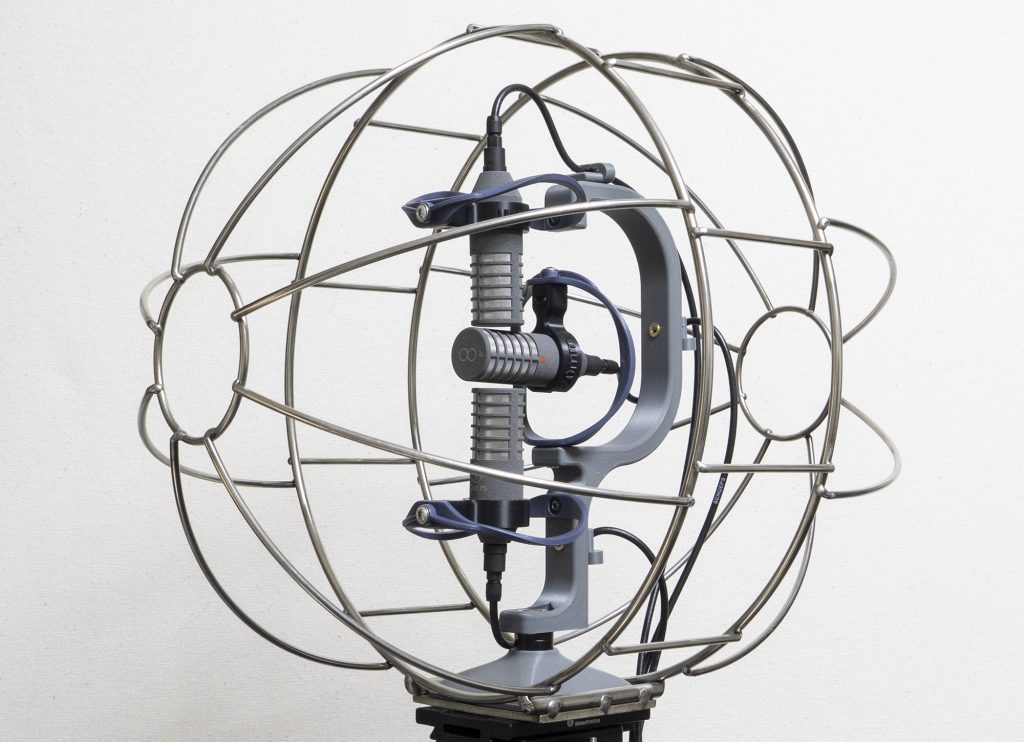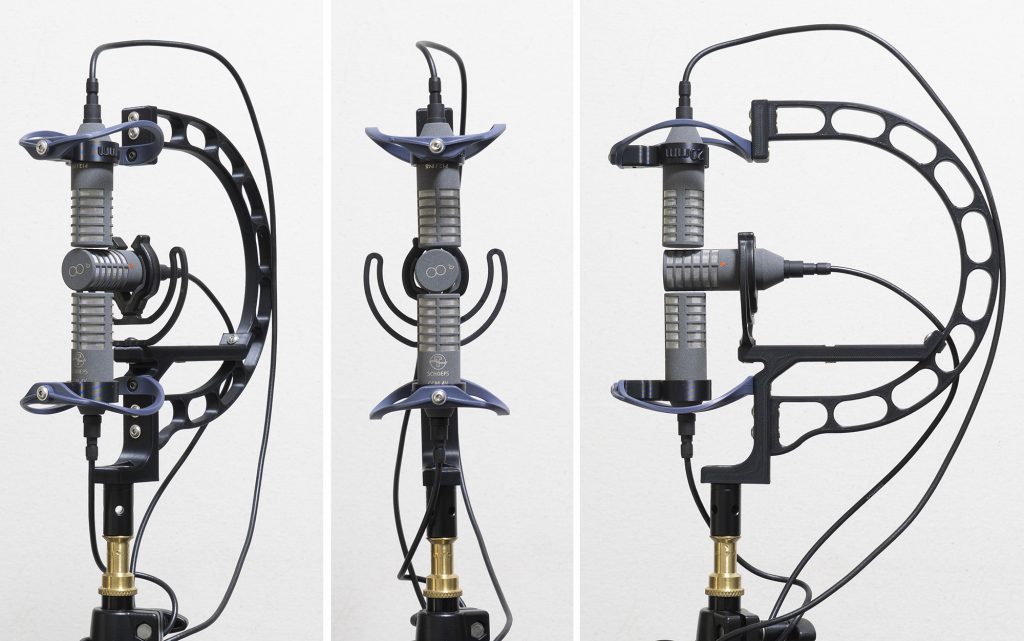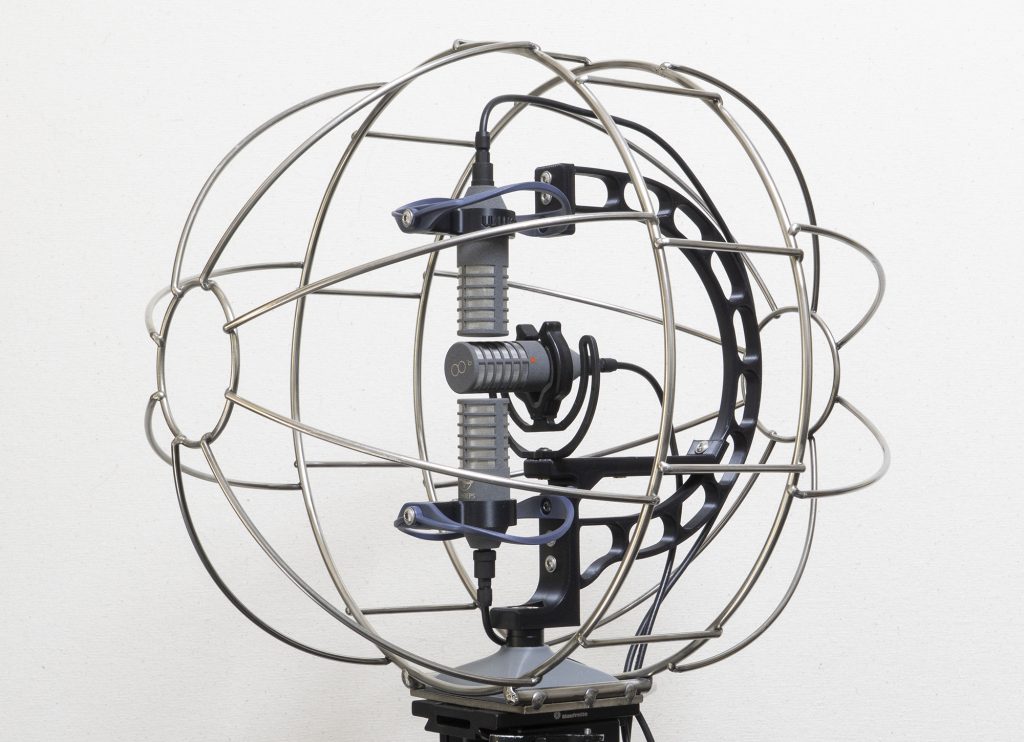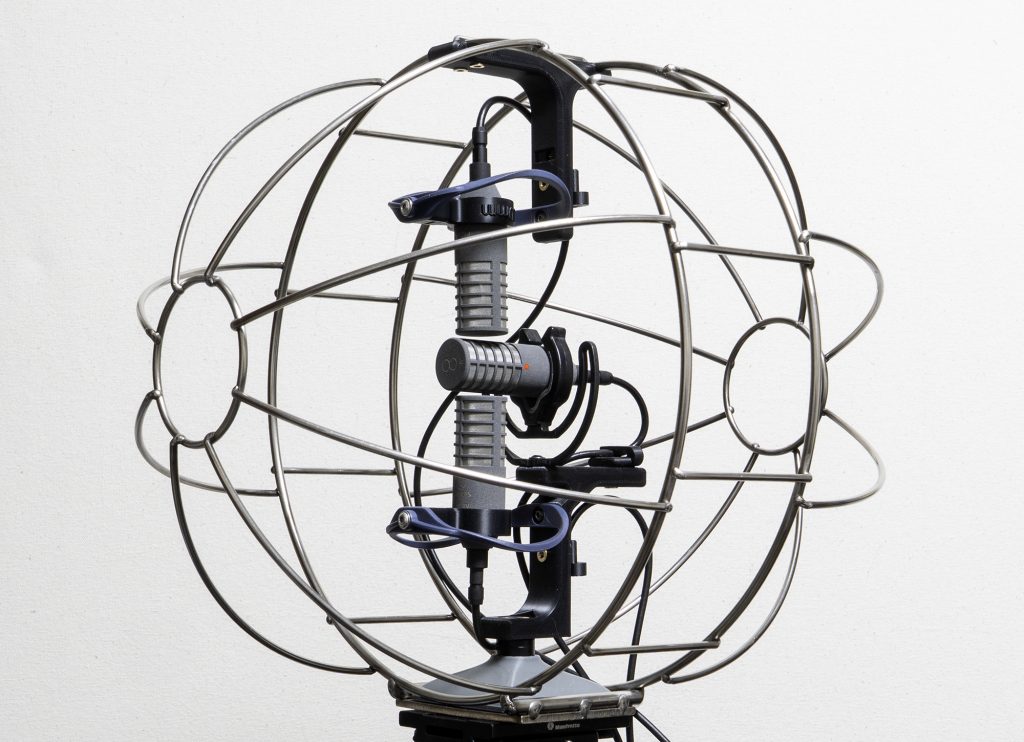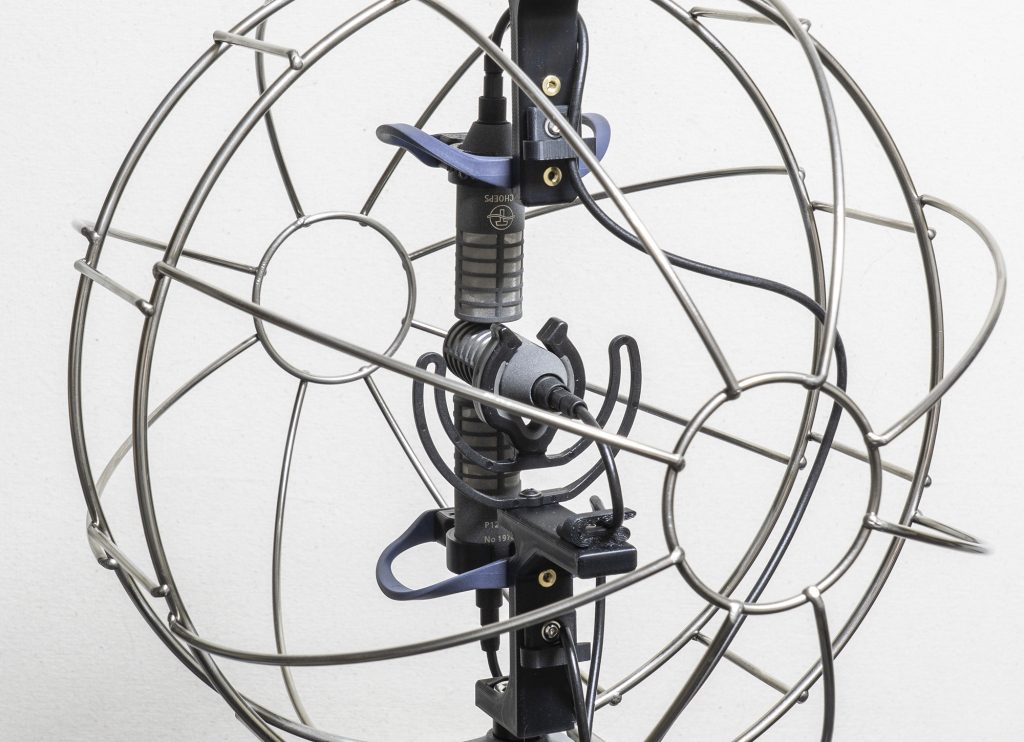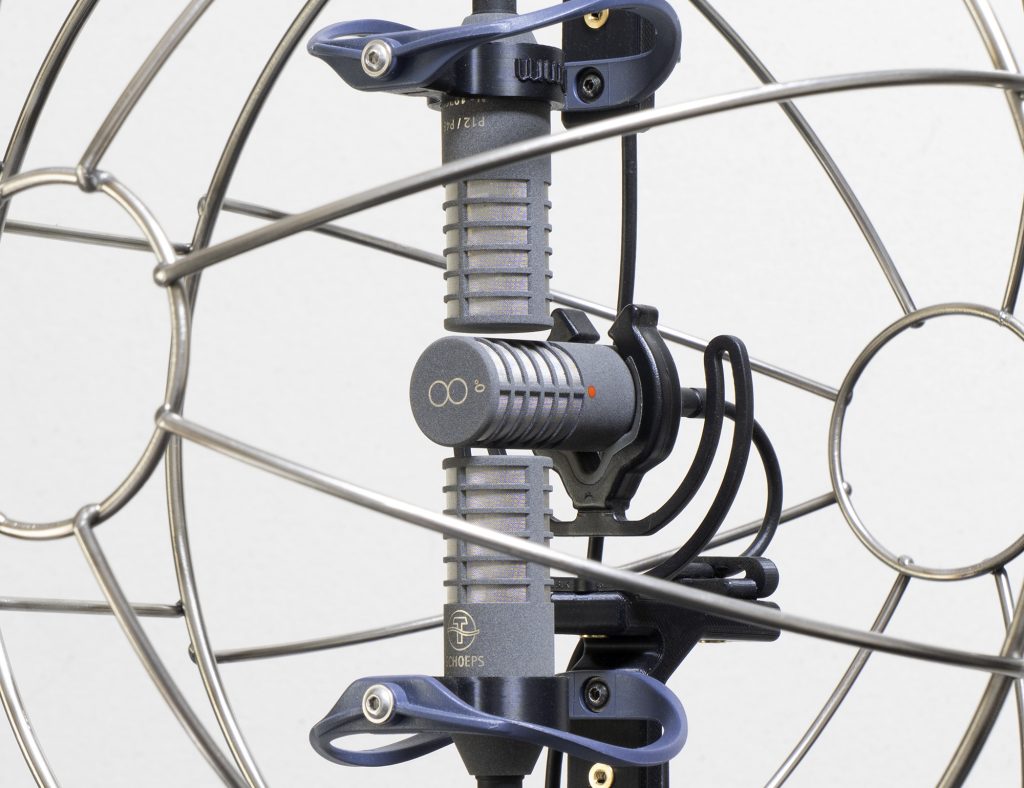
Introduction
In Part 1 of this three-part blog-post on double mid-side I covered the rigging options for DMS using SDC mics. In this second part, I explore the differences between the rigging options, focusing on the option with side-by-side end-address cardiods and the, theoretically, rather better option with side-address cardioids: are there any audible differences? And I also include some clips of recordings to give a sense of the differences between different DMS set ups: that doesn’t just mean how the mics are configured, but, also, different mics.
Shadowing
One of the criticisms thrown at any configuration of coincident mics, but especially at those with multiple mics, is of the impact of shadowing, where elements of the mic shock-mounts or, more substantially, adjacent mics colour the sound. Of the three DMS configurations that with the most obvious shadowing is, of course, the option with side-by-side cardiods: you wouldn’t normally choose to stick something the size of mic immediately adjacent to and projecting forward from a cardioid mic capsule and there is no doubt that, visually, it looks clunky. But does it sound noticeably different?
For those interested, I did some tests on the shadowing effect in such a clustered DMS rig (using MKH 8000 mics), recording pink noise played bay through one of my Vivid S12 monitors to the forward-facing cardioid in the DMS array, and then moved the fig 8 and rear-facing cardioid away (the mics were carefully set up with a separate stand for the forward-facing mic so that it remained exactly in position when the other mics were removed). This was done with the mic on axis and then 45 degrees off axis, so that, in the latter, the body of the rear-facing mic was shadowing the forward mic.
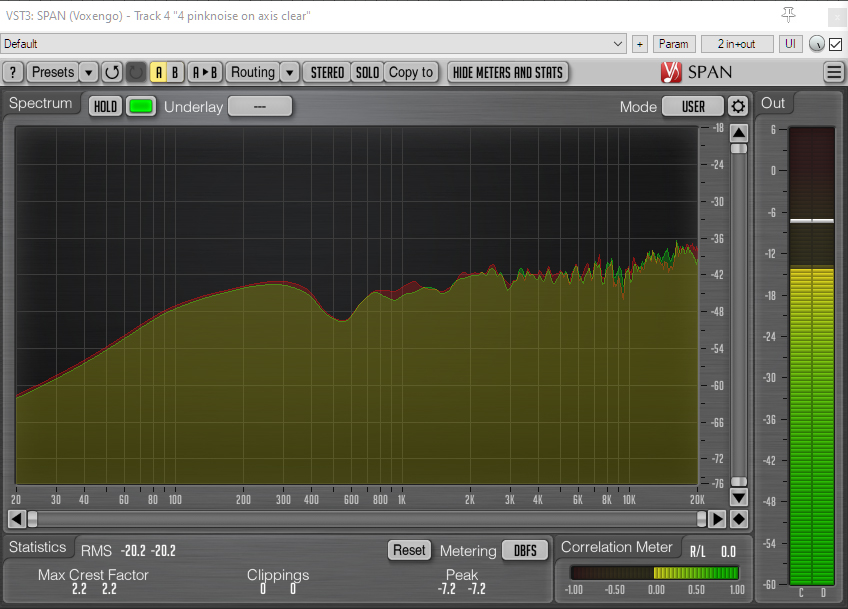
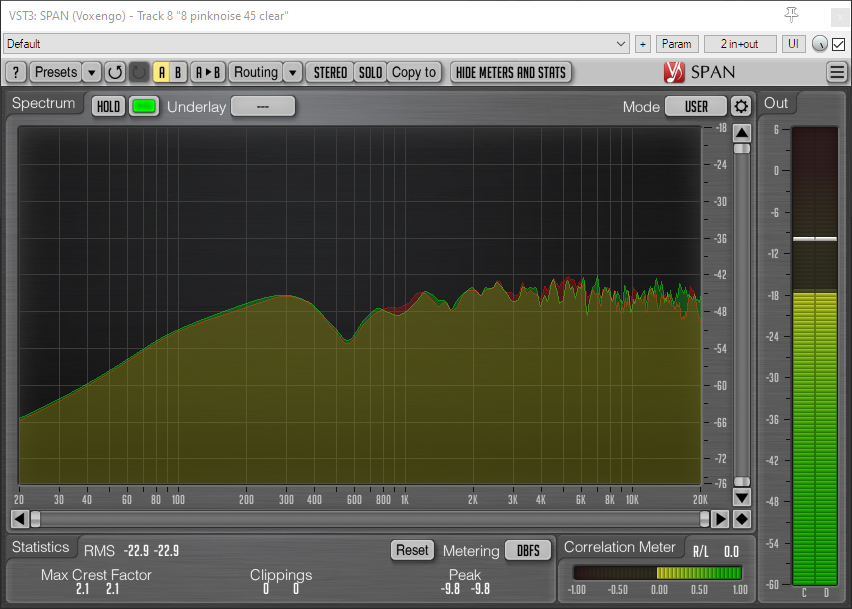
You can see from the spectrograms below that there was more of an impact on the high frequencies as expected at 45 degrees. Of itself this doesn’t show whether the differences of the single, unimpeded, cardioid mic vs the identically positioned mic within its DMS cluster are significant, so, by way of comparison we can look at some similar tests exploring the impact of two windshields (which I have shown previously). First we have the MKH 8030 with the Min-ALTO 115 basket turned side-on to the speaker source so that the fig 8 mic is on axis to the sound source:

And for another comparison, here is the same fig 8 test repeated with a Rycote Cyclone.

In short, the impact of shadowing in the DMS mic array is measurable, but is far less significant than the impact of these two windshields, where the fig 8 (obviously a key element of DMS) is affected by the structure of the windshield baskets, with the particularly noticeable difference in the Cyclone basket doubtless largely due to the substantial plastic ring for its end cap.
And to return to our shadowing tests for the DMS rig, we can listen to how the effect of shadowing actually sounds. I used the same means of removing the fig 8 and rear-facing cardioid without disturbing the forward-facing cardioid’s position as before, and again placed the mics in front of a single speaker (Vivid S12) in my studio and played back a short section of a recent recording of mine of a singer-guitarist (Luke Chapman), angling the mics on axis to the speaker and then at 45 degrees. Here are the resulting mono sound files:
First, here is the pair of recordings of the forward-facing cardioid mic on axis, with no surrounding mics, and then shadowed within the cluster of DMS mics:
Second, here is the pair of recordings of the forward-facing cardioid mic at 45 degrees, with no surrounding mics, and then shadowed within the cluster of DMS mics (the body of the rear-facing cardioid mic shadowing the forward-facing mic in particular):
Obviously, comparisons should not be made between the on-axis and the 45-degree recordings as, by definition, the mic has moved!
I suspect many listening to these examples may be surprised by how little difference there is between the two recordings (clear mic and shadowed mic) in each set up (on axis and at 45 degrees). Certainly, I was reassured that shadowing effects are less than might be feared with this more clustered version of the two options that use end-address cardioids. Obviously use of longer and larger mics (think two MKH 40s and an MKH 30) would have a greater effect, but, conversely, two still shorter cardioids (think of those 23.5mm-long Nevaton MC59uS/C2 mics) would reduce the effect more (subject to the impact of any mounts).
Of course, shadowing is only one potential downside with the clustered DMS rig with two side-by-side cardioids: both cardioids are necessarily offset from the centre of the fig 8 capsule, typically by around 12mm or more. With MS normally the recordist aims to align the mics so that one capsule is precisely directly above the other and as close as possible. Losing that vertical alignment, of course, risks introducing comb filtering to sounds directed at the mics from the horizontal plane (or whatever plane the mics are tilted toward): likewise, increasing the vertical spacing between the mics will introduce more comb filtering and narrow the horizontal band where the effects are minimal or non-existent. The last isn’t an issue with DMS with two side-by-side cardioids (indeed, it can allow the vertical distance between the fig 8 and cardioid capsules to reduce), but the former is: the question, again, is does this matter? I have heard the results of MS recordings of classical music with the mics side-by-side, which sound fine (for example search out the recordings of ex-BBC engineer, Roger Long, who, as ‘Rolo46’, has posted many marvellous MS classical music recordings on Gearspace using side-by-side MS mics, mostly with an MKH 30 pair), but do the theorists, who frown at such setups, have a point? My aim was to test this, simplifying matters by doing so with an MS pair, comparing vertically aligned mics with one with the mid mic offset as if for this DMS configuration, but, try as hard as I could, I simply could not get any method to work convincingly: I tried indoors with a single speaker, but comb filtering for the shifted mid mic was obscured by comb filtering from the room (few studios are entirely free of comb filtering: and evidently mine isn’t!), and I tried outdoors (the poor man’s anechoic chamber!), but just couldn’t get reliable, repeatable or convincing results. Perhaps I will have a moment or revelation and work out what I need to do, but in the meantime I’m sorry to have come up short: you’ll just have to hang your hat on whichever side of the debate convinces you most . And, of course, one can learn something from the comparative field recordings below (or, better, your own), which compare the different rigs in action.
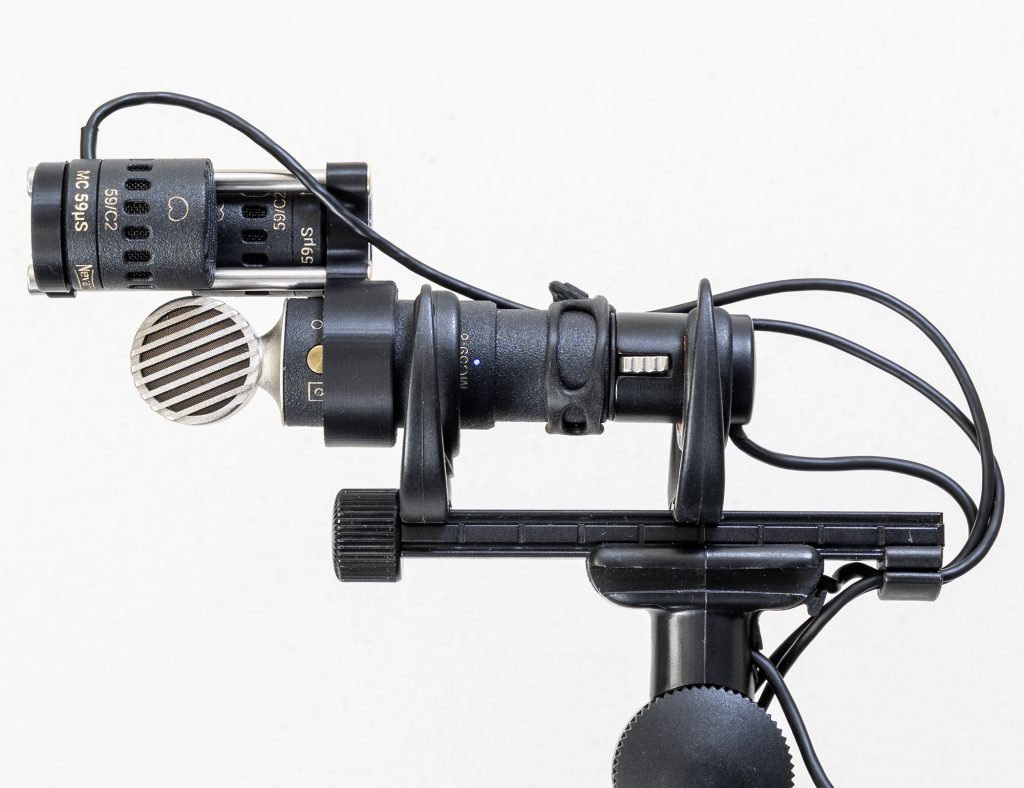
Field testing the different DMS rigs
On which note, I left behind such tests and took the mics into the field, to compare some real DMS rigs. This looked at a combination of different rigging approaches and, closely related, different microphones. I could have added a third variable of different windshields, but, to make things more fairly comparable, I have stuck with the same windshields in each set of field of tests. Being unadventurous (or just lazy?!), the tests comprise a series of my regular ‘quiet’ village street recordings: birdsong (plenty of swifts screaming overhead this summer), passing cars, and a bit of Foley-esque sound (as I open doors and gates, and stomp around aimlessly) cover quite a few bases. The cocker spaniels even joined in at one point with a bit of snuffling (honest, it wasn’t me!).
First off, I set up two rigs comprising the Schoeps CCM4V side-address cardioids and CCM8 fig 8 trio, and the Sennheiser MKH 8040 cardioids and MKH 8030 fig 8 mics for DMS with the mics side-by-side, recording with a Sound Devices 788T at 24bit/96kHz. In both cases I used Mega-Blimps for the windshields. With such large surround sound rigs two seems a sensible limit: three or more would mean that they are spaced rather too far apart to be comparable. Here is a short clip (1:34) of the resultant recordings, with one mono file for each mic (levels balanced according to mic sensitivity, but with no other processing) so that you can play around with them in, say, the Schoeps DMS or Harpex-X plugins: I use both for DMS processing.
a) Sennheiser:
b) Schoeps:
c) and here are two stereo files, generated in Reaper using Harpex-X (with the Blumlein stereo preset):
Second, here are the mono files for a similar test comparing DMS with the Sennheiser MKH 8040 cardioids and MKH 8030 fig 8 mics vs the Nevaton MC59uS/C2 and MC59/8 mics, again using Mega-Blimps for both rigs:
d) Sennheiser:
e) Nevaton
f) and here are two stereo outputs, generated using Harpex-X (with the Blumlein stereo preset):
And, finally, here are the mono files for another garden test, this time with a bit of wind (but no low-pass filtering applied), comparing DMS with the Schoeps CCM4V side-address cardioids and CCM8 fig 8 vs the Nevaton MC59uS/C2 and MC59/8 mics, again using Mega-Blimps for both rigs:
g) Schoeps:
h) Nevaton:
i) and here are two stereo outputs, generated using Harpex-X (with the Blumlein stereo preset):
Now anyone who downloads all those files and listens to them deserves a medal!
Conclusions
It is extraordinarily difficult to draw conclusions that are relevant to others’ use of DMS (not least since the use of side-address and end-address cardioids inherently means using different mics), but, nonetheless, I will have a stab at this. First off, although generally relaxed about multi-mic coincident pairs and the impacts of shadowing and small offsets, I came into these tests with an expectation that the acoustic problems of side-by-side cardioids in what is doubtless the most popular configuration of DMS would be more noticeable than they have proved to be. In reality, and that is with the caveat that I have not been testing DMS with bulkier SDCs such as the MKH 30 and MKH 40, they are much less significant than the impact of many windshields, especially those that were not designed to offer as much transparency to the sides and rear as to a forward-facing directional mic. So, if the aim is to place a DMS rig in a Radius Windshields Mini-ALTO or a Rycote Cyclone, then the consequences of the mic configuration are nothing compared to the impact of the windshield. However, if using a windshield with much better all round transparency such as the Cinela Pianissimo or, if boom pole use is not needed, one of my Mega-Bimps, then the impact of the different configurations will come into play. But this then gets very complex for several reasons: yes, the Schoeps CCM4V side-address cardioids and CCM8 fig 8 offer good alignment and little no shadowing (both from the other mics and the mounts), so using them in a Cinela Zephyx (for lightness) or Mega-Blimp (for more transparency) would offer the best performance from that perspective. But, at the same time, they have higher self-noise than the MKH 8030 + 2x MKH 8040 setup and lack the more humidity-proof RF technology of the Sennheiser mics. And, of course, the Nevaton MC59/8 + 2x MC59uS/C2 rig offers the most minimal shadowing for DMS with side-by-side cardioids (due to the very short length of the cardioids) as well as the lowest self-noise. As for the sound, well that’s one for individuals. I think the Nevaton DMS rig is the best sounding irrespective of mic configuration, but I may be missing something that more refined ears can pick up. Or perhaps it is just taste: it’s not as if top end classical music recordists all prefer the same mics or the same mics for a specific task.
And, just to add complexity where you don’t need it, I was surprised by the difference between the two plugins I have been using – Schoeps’s own DMS plugin and Harpex-X. In part, at least, this seems a product of the Schoeps plugin having built-in gain and frequency response compensation for its mics (which, evidently, isn’t appropriate for other mics), but the upshot is that it is very easy to get more significant differences by processing the recordings differently than it is from the actual mics or configurations used.
If you have all these mics (or, indeed, other good options) the selection criteria will need to balance all these factors: if you have some of the mics only, then that will simplify the choices; and if you have none of the options, but are thinking of one, then the usefulness of the mics for different purposes are likely to come into play (e.g. would you have use for Schoeps CCM4V side-address cardioids, or would end-address cardioids be more use?).
As for my choices? Well, I don’t own the Schoeps mics, so that does simplify things as the advantages of side-address cardioids wasn’t clear enough for me to buy the mics (especially with no other Schoeps mics in my locker), so DMS for me will be MKH 8000 mics (for tougher conditions) in a Mega-Blimp; otherwise, I will be using the Nevaton MC59/8 + 2x MC59uS/C2 rig in the same windshield for, as I said, to my ears, the best sound and, less subjectively, for even lower self-noise. And for ultra-compact DMS, should I ever need it, I would use either rig in a Nanoshield (the Nevaton DMS won’t fit in a Mini-ALTO, and the Sennheiser rig isn’t suited to the Mini-ALTO due to the fig 8 position in relation to the chunky plastic rings). But, the question I still need to address for my own use is whether DMS is preferable to horizontal B-format: and that, of course, is for Part 3 of my DMS blog-post series!
